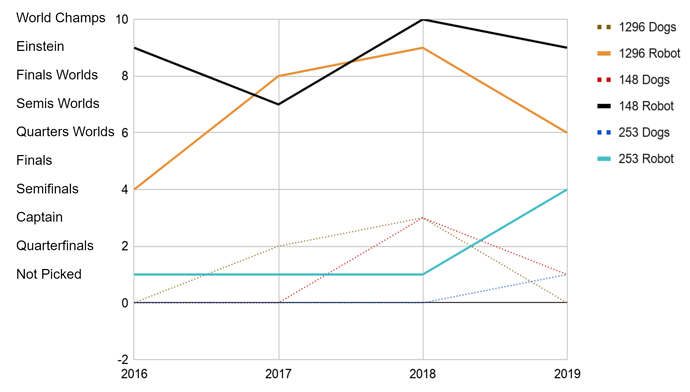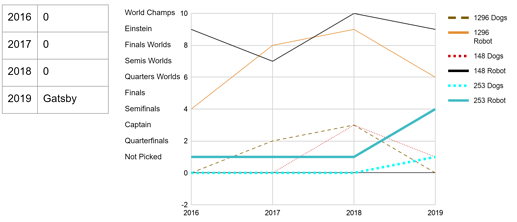cover photo credit: Darren_Collins, 2046 – Lead Mentor
Hypothesis: Shop dogs lessen team anxiety and stress, thus allowing teams to be more clear and focused during the meeting to accomplish tasks.
Additionally, they allow mentors to spend more time at the shop, helping with student learning and efficiency.
Prediction: Shop dogs lead to team success
Data and Methods:
I compiled data on 3 teams across 4 years; 1296, 148, and 253 for years 2016, 2017, 2018, 2019. I was able to use personal observation and TBA to verify the number of dogs and official event results of 1296 and 253. I cross referenced personal observations with JVN’s build blog for 148’s data.
Team performance is converted to numerical data by assigning a team’s performance to their highest point of success in a season based off the following:
| Top advancement | Value |
|---|---|
| Not Picked | 1 |
| Quarterfinals | 2 |
| Captain | 3 |
| Semifinals | 4 |
| Finals | 5 |
| Quarters Worlds | 6 |
| Semis Worlds | 7 |
| Finals Worlds | 8 |
| Einstein | 9 |
| World Champs | 10 |
The results:
Lets start with 253:
In previous years they did not have any shop dogs. This year (2019) they have been visited by a dog multiple times (Gatsby). In 2019, the team’s highest achievements were ranking 3rd and making it to semifinals.
Next, 1296:
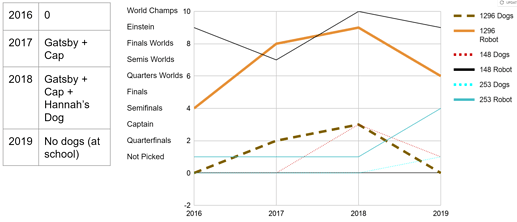
1296 shows that with more shop dogs comes more success. In 2016, the team had no shop dogs. In 2017, dogs Captain and Gatsby joined the team. In 2018, a student’s dog also made appearances at the shop. However, in 2019 the team moved facilities to a school – where dogs were not allowed.
Finally, 148:
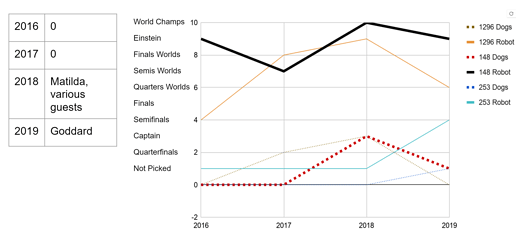
Conclusion:
More shop dogs = more success Less shop dogs = less success
I propose that teams should be encouraged to have furry visitors to reduce team stress and improve robot performance. Thus, I think FIRST should present The Paws Award to teams who best incorporate dogs into their team dynamics and are role models for other teams to emulate.
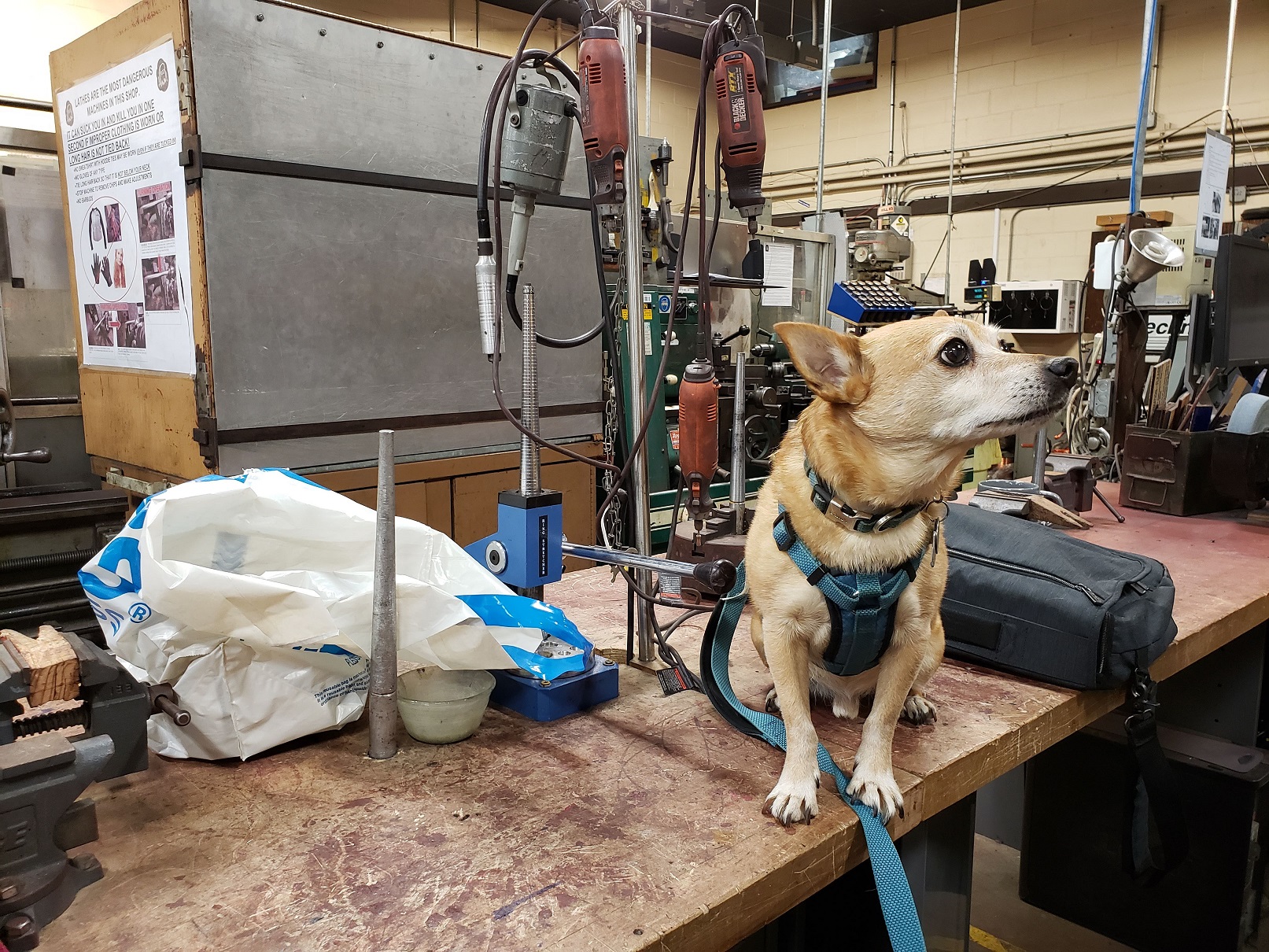
Everyone should be yelling at their computer, “CORRELATION IS NOT CAUSATION” and I applaud you for that. But that’s just the first problem with my report.
Lets consider the following:
- What are my motives for presenting this data?
- Where this data come from? Is it valid?
- What are other factors that could play a part?
What are my motives for presenting this data?
I have a dog and I want to be able to bring it to robotics. If you are aware of my personal history, you’d know that I like bringing my dog to things. Also I think its a funny correlation.
Where this data come from? Is it valid?
So as I reported, this data came from blogs, personal observation, and TBA. Those seem like reputable sources, right? However, can we trust that JVN would post about every dog that walked into 148’s shop? Is my memory perfect?
Which leads to the next part: what constitutes a shop dog? Can they visit once and be counted? Do they need to visit multiple times? How many times? Do they need to meet the same time requirements as team members?
253 has seen Gatsby maybe 3 or 4 times – hardly a serious contender for “shop dog.”
Gatsby and Cap were around very frequently in 2017 and 2018 and would be easily considered shop dogs, but I also counted Hannah’s dog who visited once or twice.
As for 148 – I could only go off stories, memory, and the blog. I don’t know the frequency or duration of the dog visits so I could interpret the data as I wished.
I also didn’t bring up any other teams with dogs – 125 has shop dogs, as does 5940. It could be because I didn’t have that information (I don’t) but also because its likely that including their data would nullify my conclusion.
What are other factors that could play a part?
Team performance changes from year to year and its hard to pinpoint a specific factor. But its worth noting that 1296’s dog status changed due to their change in venue but also because one of the dogs moved to California along with two mentors. Losing key mentors can be a tough transition for teams. Similarly, this is the first year in known history that 253 has had technical mentors (4.5 of them to be precise). It also happens that one of their mentors has a dog.
148 is a consistently high performing team and frequently reach the furthest stages of the competition – at which point success is also tied to luck. The minor variations in their performance could be correlated with many things, and I chose to use dogs.
Why are you doing this?
Mostly because I found the correlation in 2018 and thought it was funny, but I realized there is some value in this exercise:
- Be skeptical of data, especially when it comes from one source
-
- Question the motives of the presenter (are they friends with someone, are they trying to promote their idea)
- Question how they gathered that data (did they use reliable and repeatable measures)
- Question the data they gathered (did they gather enough data, did they gather the right data)
- There is a story behind the data
- As it applies to robots: don’t just use numbers to identify a team’s strengths. Look at trends. Try to find the story behind why the trends change.
- Just because it looks like correlation, does not mean its causation – it might not even be correlation
- I like shop dogs
- except when they makes others uncomfortable (eg allergies and phobias)
Further Reading:
Winston, 148 dog visitor
Pasta and Pesto, 125 dogs
Gatsby, my dog
Show Me Your Shop Dogs
Conversation about this article can be found here.


